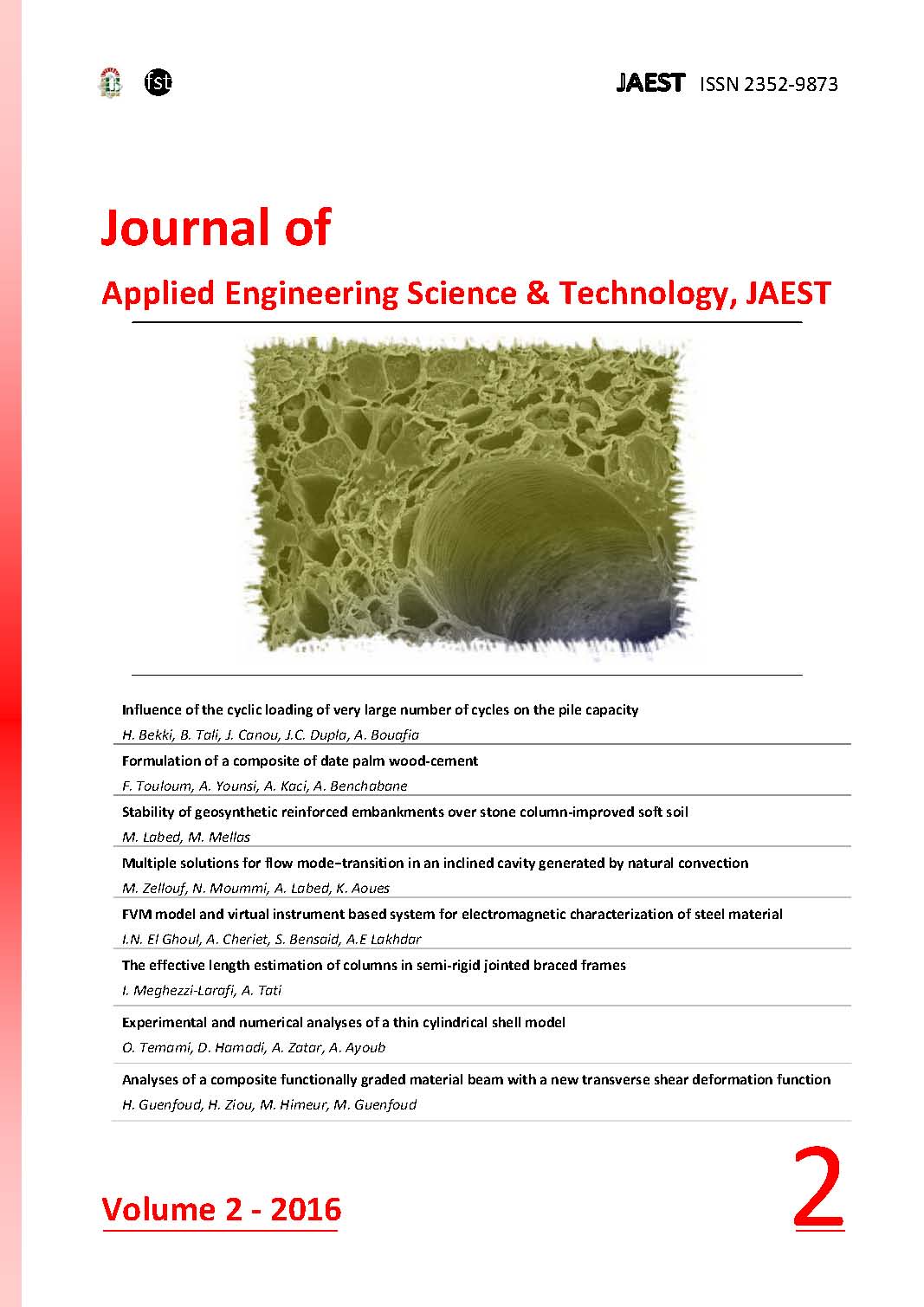DOI:
https://doi.org/10.69717/jaest.v2.i2.42Keywords:
Effective length factor, Semi-rigid connection, Braced frame, Relative stiffness coefficientAbstract
This paper presents a theoretical and exact procedure for the stability analysis of braced
steel frames, taking in account the flexibility effect of the beam-column connections. In order to
determine the effective length factor (K-factor). The isolated subassembly approach is used to
establish the buckling governing equation. In this study, the relative stiffness coefficient at the
isolated column ends is provided by the remainder members of the structure, rather than of the
relative stiffness factor in the alignment chart method. A computer program for plane structure
analysis is used to evaluate the relative stiffness coefficients. To illustrate the accuracy of the
established transcendental equation, K-factor values for the case of fully rigid connections, are
compared to the exact and the French rules results. The effect of the type of transfer elements
between the frame members, in term of fixity factors is investigated. Moreover, the effect of
restraining conditions, provided by the whole frame structure, in term of relative stiffness
coefficients, is also studied. The obtained results revealed that the buckling critical loads of the
columns in frames of rigid members are significantly affected by the fixity factors variation, unlike
in flexible structures.
Downloads
Downloads
Published
Issue
Section
License

This work is licensed under a Creative Commons Attribution-NonCommercial 4.0 International License.
How to Cite
Most read articles by the same author(s)
- Mohamed-Ouejdi Belarbi, Abdelouahab Tati, Abdelhak Khechai, Houdayfa Ounis, A new 4-node quadrilateral element based on layerwise approach for free vibration analysis of laminate-faced sandwich plates , Journal of Applied Engineering Science & Technology: Vol. 2 No. 1 (2016): JAEST
Similar Articles
- Mohamed-Amine Khadraoui, Leila Sriti, Study and optimization of the windows’ impact on thermal comfort and energy efficiency (Case of offices in a hot and arid climate) , Journal of Applied Engineering Science & Technology: Vol. 4 No. 1 (2018): JAEST
- Wafa Bentrah, Salim Sbaa, Nadjiba Terki, Noureddine Bessous, A new frequency analysis for diagnosis of bearing defects in induction motors using the adaptive lifting scheme of wavelet transforms , Journal of Applied Engineering Science & Technology: Vol. 4 No. 2 (2018): JAEST
- Sara Sedira, Said Mazouz, Effect of urban morphology on thermal comfort in outdoor spaces: the case of the red village-El Kantara-Biskra , Journal of Applied Engineering Science & Technology: Vol. 4 No. 1 (2018): JAEST
- Mohamed-Ali Djebiret, Brahim Abbad, Adel Benchabane, Maamar Ouali, Ferhat Yahi, Mohand Berdja, Amar Rouag, Experimental study of solar adsorption refrigeration device , Journal of Applied Engineering Science & Technology: Vol. 4 No. 2 (2018): JAEST
- Salah Zerguine, Djamel Benmeddour, Abdallah Zatar, Numerical study of seismic earth pressures acting against a vertical retaining wall in frictional soil , Journal of Applied Engineering Science & Technology: Vol. 2 No. 1 (2016): JAEST
- Miloud Koussa, Mohamed-Tewfik Bouziane, Contribution of the geographic information system for groundwater to the mapping of subterranean waters in the region Djelfa (Algeria) , Journal of Applied Engineering Science & Technology: Vol. 3 No. 2 (2017): JAEST
- Mohamed Baheddi, Youcef Youb, Study of the behavior of bridges under seismic loads considering soil-structure interaction , Journal of Applied Engineering Science & Technology: Vol. 1 No. 2 (2015): JAEST
- Hamza Guenfoud, Hassina Ziou, Mohamed Himeur, Mohamed Guenfoud, Analyses of a composite functionally graded material beam with a new transverse shear deformation function , Journal of Applied Engineering Science & Technology: Vol. 2 No. 2 (2016): JAEST
- Abdelmalek Hasseine, Ahleme Aidaoui, Recovery of acetic acid from aqueous solutions using salting effect , Journal of Applied Engineering Science & Technology: Vol. 4 No. 1 (2018): JAEST
- Sihem Latreche, Leila Sriti, Improving thermal comfort conditions through the optimization of the self-product residential buildings envelope. Case of a region with a hot and arid climate: Biskra , Journal of Applied Engineering Science & Technology: Vol. 4 No. 2 (2018): JAEST
You may also start an advanced similarity search for this article.





